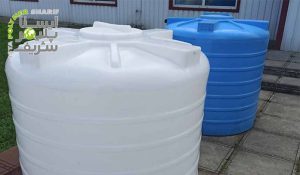Whether you have a large tank or a 3,000-gallon tank, you will likely reach a point where your stored water exceeds the capacity of your storage tank. In such a case, you may need to connect multiple tanks. Increasing water storage capacity by linking tanks is an effective and practical method for managing water reserves. There are several methods to connect multiple tanks to increase your storage capacity. Below, we discuss increasing water storage capacity using multiple tanks.
Methods for Increasing Water Storage Capacity by Connecting Tanks
When connecting your tanks with pipes, you can link them from the top or the bottom. Top connecting tanks means the first tank fills before overflowing into the next tank. Bottom connecting tanks allows all tanks to fill evenly as they reach the minimum water level. We will explain these two methods further below:
Connecting Tanks from the Top
Tanks can be connected via an overflow from one tank to another. As the first tank fills with water, it overflows through pipes leading to the inlet of your next tank. The overflow outlet should be the same size as the inlet. The last tank in the overflow sequence is screened and leads to water drainage for your intended use.
It is important to note that the maximum water level in all tanks in your system is limited by the height of the overflow pipe from the first tank in the series. Considering this, the first tank should have the highest height, and each additional tank should be slightly lower. It is best to connect all tanks under them with a connecting pipe. The water then flows into this pipe, accessing all your stored rainwater.
It is a good idea to have an isolation valve on each tank so you can control the release of water in the tank. While this setup is more complex than bottom connecting, it can offer more benefits. If you want your tanks to fill simultaneously, open all the valves. If you prefer to fill the tanks individually, close them all one after another, except the first one, and open the next tank as needed.
Connecting Tanks from the Bottom
Connecting tanks from the bottom with pipes from one tank to the next allows all your water tanks to fill evenly. As rainwater enters the first tank, it flows into your second tank until it reaches the same level. At this point, both tanks fill equally. The advantage of this increased storage capacity is that you only need to draw water from the first tank or the lowest tank.

You also need an overflow cut, which simplifies water supply significantly. Note that the tops of the tanks (overflow levels) should be aligned. This usually means placing the lower tanks on higher bases or excavating under your higher tank. When using this method, it is important to consider isolation valves so that if one tank leaks, it does not drain all your tanks.
Advantages of Increasing Water Storage Capacity by Connecting Multiple Tanks
Connecting water tanks is an easy way to increase water storage capacity without additional plumbing work. Here are the benefits of connecting multiple tanks:
- Increased Water Storage: If there is a connection between the water tanks, it is easy to switch from one tank to another. During this process, not much water is lost. Connecting multiple tanks is a complex process. However, this is done once and will increase water storage forever.
- Rainwater Harvesting: Harvesting rainwater with multiple tanks is simpler. Having different water tanks increases the volume of space for storing rainwater. This also reduces water loss in multiple tanks. Since there is more than one tank, if one tank faces a problem, the other tanks compensate for the issue.
- Suitable for Narrow Spaces: If you live in a small area, it is better to use several small tanks. Connecting multiple small tanks is easier than setting up one very large tank. Using multiple tanks in such cases also helps collect more water.
- Providing Smart Solutions: Having multiple tanks allows for separation. One tank can be for storing rainwater, while another can be for stormwater storage. Additionally, installing multiple tanks in different locations is also a smart solution. This allows the user to connect the tanks and store more water for their needs.
Conclusion
When it comes to water tanks, everyone has different needs. The demand for water is increasing daily. Deciding whether to buy multiple tanks or one water tank is challenging; however, connecting multiple tanks to increase storage capacity can offer more benefits than one large tank. Firstly, you can save on costs by not buying additional tanks, and you also have the ability to store more water for your daily needs.






